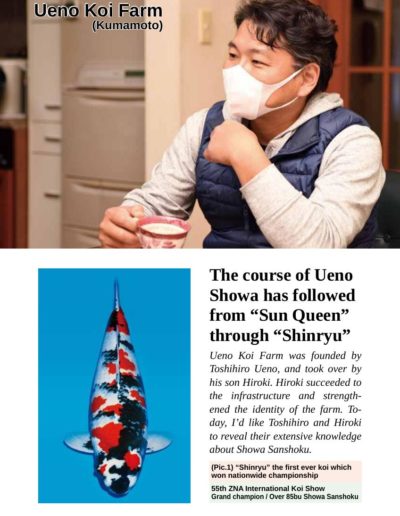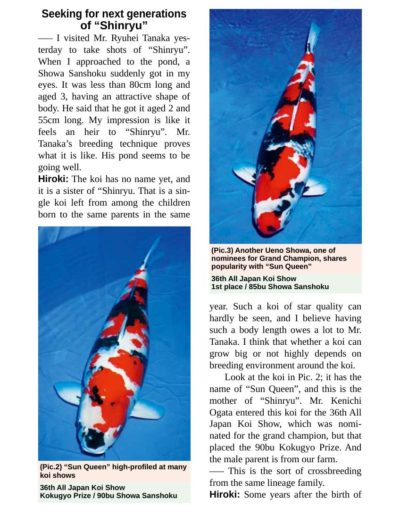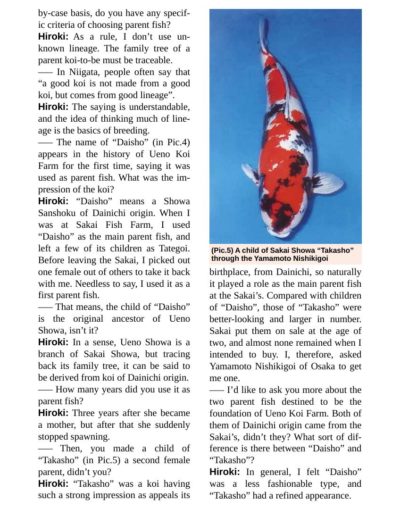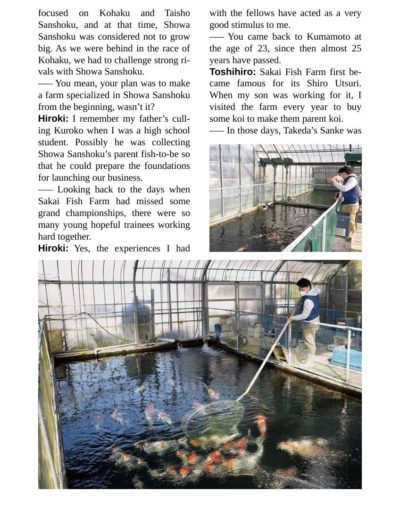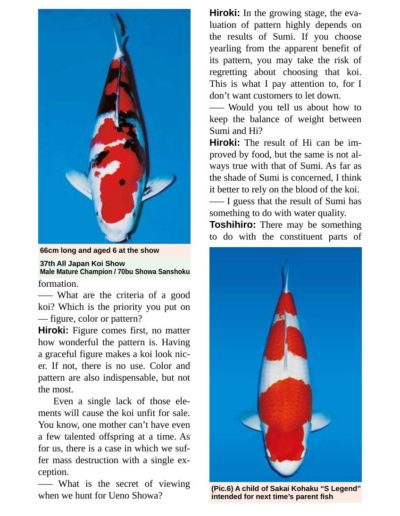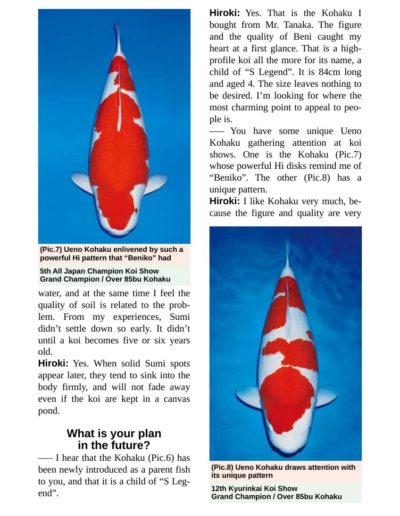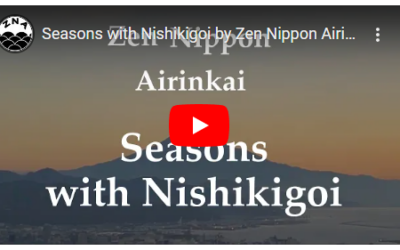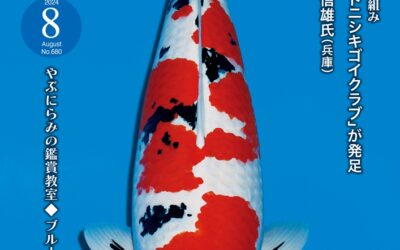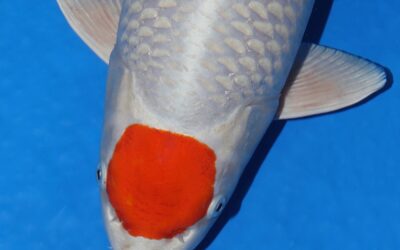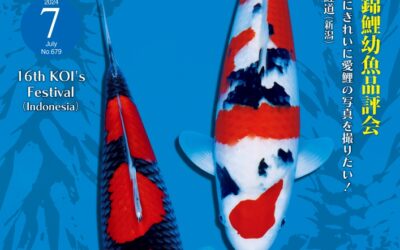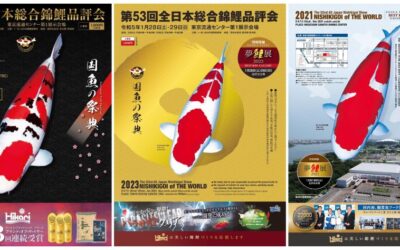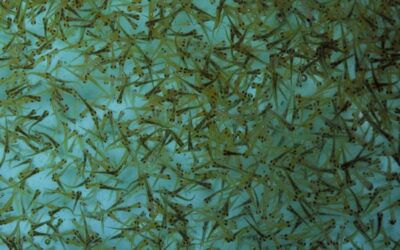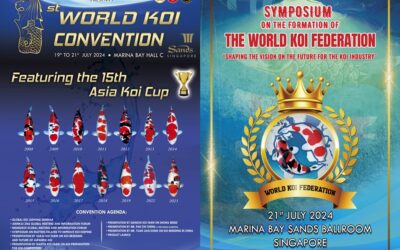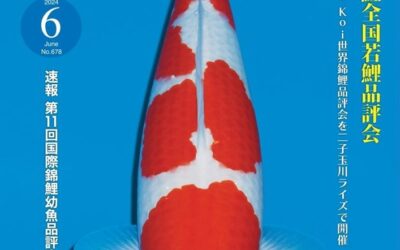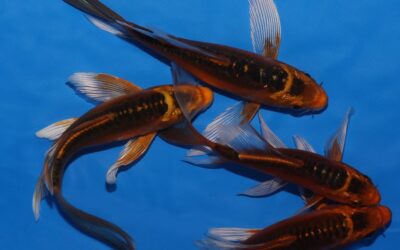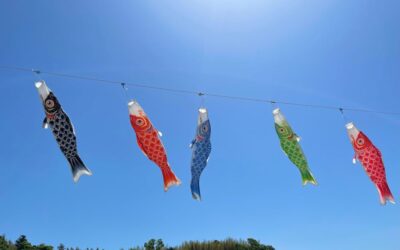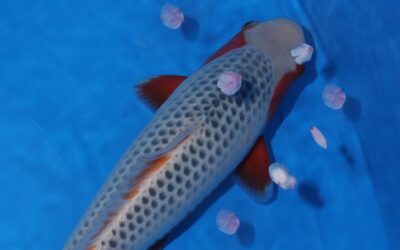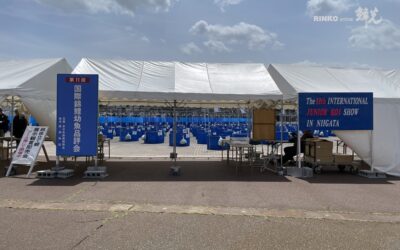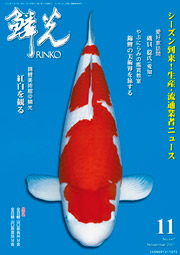The course of Ueno Showa has followed from “Sun Queen” through “Shinryu”
Ueno Koi Farm (Kumamoto)
** This article is originally from the issue No.770 (March 2021)
Ueno Koi Farm was founded by Toshihiro Ueno, and took over by his son Hiroki. Hiroki succeeded to the infrastructure and strengthened the identity of the farm. Today, I&lquote;d like Toshihiro and Hiroki to reveal their extensive knowledge about Showa Sanshoku.
Seeking for next generations of “Shinryu”
—I visited Mr. Ryuhei Tanaka yesterday to take shots of “Shinryu”. When I approached to the pond, a Showa Sanshoku suddenly got in my eyes. It was less than 80cm long and aged 3, having an attractive shape of body. He said that he got it aged 2 and 55cm long. My impression is like it feels an heir to “Shinryu”. Mr. Tanaka&lquote;s breeding technique proves what it is like. His pond seems to be going well.
Hiroki: The koi has no name yet, and it is a sister of “Shinryu. That is a single koi left from among the children born to the same parents in the same year. Such a koi of star quality can hardly be seen, and I believe having such a body length owes a lot to Mr. Tanaka. I think that whether a koi can grow big or not highly depends on breeding environment around the koi.
Look at the koi in Pic. 2; it has the name of “Sun Queen”, and this is the mother of “Shinryu”. Mr. Kenichi Ogata entered this koi for the 36th All Japan Koi Show, which was nominated for the grand champion, but that placed the 90bu Kokugyo Prize. And the male parent is from our farm.
—This is the sort of crossbreeding from the same lineage family.
Hiroki: Some years after the birth of “Shinryu”, I tried replacing the male parent with another hopefully for better development. But I noticed that the original male is second to none.
—I remember seeing another Showa Sanshoku (Pic.3) of Mr. Ogata&lquote;s own in the same koi show. That koi was also among other nominees for the grand champion. From this, Ueno Showa&lquote;s popularity spread drastically and widely in Japan.
Hiroki: That Showa Sanshoku is a sister of “Sun Queen”, and the nomination happened to it in 2005.
—I feel that “Shinryu” has some similarities in impression to “Sun Queen”.
Hiroki: As the history of establishing the species is still short, there are less examples of Showa Sanshoku&lquote;s crossbreeding between different varieties. I always picture of the birth of Showa Sanshoku in next generations while awaiting the smallest advance of evolution.
Lately we are trying many different ways to improve our Showa Sanshoku, for example, by introducing parent fish from Rikoen, Okayama Momotaro-Koi, and others to get good hints of crossbreeding. It is a matter of course that we should stick to our existing course, but we don&lquote;t block a new attempt.
“Ueno Showa” originated in “Daisho” and “Takasho”
—Although it is a matter of a case-by-case basis, do you have any specific criteria of choosing parent fish?
Hiroki: As a rule, I don&lquote;t use unknown lineage. The family tree of a parent koi-to-be must be traceable.
—In Niigata, people often say that “a good koi is not made from a good koi, but comes from good lineage”.
Hiroki: The saying is understandable, and the idea of thinking much of lineage is the basics of breeding.
—The name of “Daisho” (in Pic.4) appears in the history of Ueno Koi Farm for the first time, saying it was used as parent fish. What was the impression of the koi?
Hiroki: “Daisho” means a Showa Sanshoku of Dainichi origin. When I was at Sakai Fish Farm, I used “Daisho” as the main parent fish, and left a few of its children as Tategoi. Before leaving the Sakai, I picked out one female out of others to take it back with me. Needless to say, I used it as a first parent fish.
—That means, the child of “Daisho” is the original ancestor of Ueno Showa, isn&lquote;t it?
Hiroki: In a sense, Ueno Showa is a branch of Sakai Showa, but tracing back its family tree, it can be said to be derived from koi of Dainichi origin.
—How many years did you use it as parent fish?
Hiroki: Three years after she became a mother, but after that she suddenly stopped spawning.
—Then, you made a child of “Takasho” (in Pic.5) a second female parent, didn&lquote;t you?
Hiroki: “Takasho” was a koi having such a strong impression as appeals its birthplace, from Dainichi, so naturally it played a role as the main parent fish at the Sakai&lquote;s. Compared with children of “Daisho”, those of “Takasho” were better-looking and larger in number. Sakai put them on sale at the age of two, and almost none remained when I intended to buy. I, therefore, asked Yamamoto Nishikigoi of Osaka to get me one.
—I&lquote;d like to ask you more about the two parent fish destined to be the foundation of Ueno Koi Farm. Both of them of Dainichi origin came from the Sakai&lquote;s, didn&lquote;t they? What sort of difference is there between “Daisho” and “Takasho”?
Hiroki: In general, I felt “Daisho” was a less fashionable type, and “Takasho” had a refined appearance.
—The parent koi you used first was a child of “Daisho”s. The breeding in the first and second year in a row was a great success. There were many big koi appearing. In the third year you replaced the existing mother with a new one, a child of “Takasho”. And that koi was greater, which became a mother of such talented koi as “Sun Queen”.
Ueno aims specially at Showa Sanshoku
—What is the proportion of Showa Sanshoku to others in your farm?
Hiroki: I should say almost all of our involvement is in Showa Sanshoku.
—From how many females are you collecting eggs now?
Hiroki: Usually we use around ten. But if Kuroko appear more than expected, the number of female of the year is to be reduced.
—What is the current percentage of Kuroko?
Hiroki: It varies according to different combinations of parent fish. Recently it is 30 to 40 percent on average.
—What are the steps taken when culling koi?
Hiroki: After culling Kuroko, I wait until they become three to four centimeters long. It is the time when a first culling is conducted. After that, I don&lquote;t ask other people to cull koi. I do it by myself very strictly.
Ueno leaves its dreams to Showa Sanshoku
Toshihiro: In the days when our farm was founded, the koi industry mainly focused on Kohaku and Taisho Sanshoku, and at that time, Showa Sanshoku was considered not to grow big. As we were behind in the race of Kohaku, we had to challenge strong rivals with Showa Sanshoku.
—You mean, your plan was to make a farm specialized in Showa Sanshoku from the beginning, wasn&lquote;t it?
Hiroki: I remember my father&lquote;s culling Kuroko when I was a high school student. Possibly he was collecting Showa Sanshoku&lquote;s parent fish-to-be so that he could prepare the foundations for launching our business.
—Looking back to the days when Sakai Fish Farm had missed some grand championships, there were so many young hopeful trainees working hard together.
Hiroki: Yes, the experiences I had with the fellows have acted as a very good stimulus to me.
—You came back to Kumamoto at the age of 23, since then almost 25 years have passed.
Toshihiro: Sakai Fish Farm first became famous for its Shiro Utsuri. When my son was working for it, I visited the farm every year to buy some koi to make them parent koi.
—In those days, Takeda&lquote;s Sanke was the most popular of any others, wasn&lquote;t it?
Toshihiro: I bought many parent koi at the Takeda&lquote;s too.
—Toshihiro, I hear that you built up the foundation through your distraction?
Hiroki: Yes, sort of. Even if everything comes from his hobby, my father prepared for necessary pond equipment. He had many friendly supporters around him, who were in the same line of business, and he had many good customers at that. He has managed to make the farm what it is today.
—You say, “Shinryu” has been raised in the pond since it was taken out of a nursery pond. Don&lquote;t you rear it in a field pond?
Hiroki: We used to, but we have phased down the use of the field pond since 12 to 13 years ago. We put it aside completely.
How to view & keep Ueno Showa
—The species of Showa Sanshoku transforms itself a lot. Where is the threshold of patience between going ahead and withdrawal?
Hiroki: As far as they are still in the stages of yearling and two-year-olds, it is too early to assess. Our customers are very aware of it, and that they are likely enjoying every process of transformation.
—What are the criteria of a good koi? Which is the priority you put on —figure, color or pattern?
Hiroki: Figure comes first, no matter how wonderful the pattern is. Having a graceful figure makes a koi look nicer. If not, there is no use. Color and pattern are also indispensable, but not the most.
Even a single lack of those elements will cause the koi unfit for sale. You know, one mother can&lquote;t have even a few talented offspring at a time. As for us, there is a case in which we suffer mass destruction with a single exception.
—What is the secret of viewing when we hunt for Ueno Showa?
Hiroki: In the growing stage, the evaluation of pattern highly depends on the results of Sumi. If you choose yearling from the apparent benefit of its pattern, you may take the risk of regretting about choosing that koi. This is what I pay attention to, for I don&lquote;t want customers to let down.
—Would you tell us about how to keep the balance of weight between Sumi and Hi?
Hiroki: The result of Hi can be improved by food, but the same is not always true with that of Sumi. As far as the shade of Sumi is concerned, I think it better to rely on the blood of the koi.
—I guess that the result of Sumi has something to do with water quality.
Toshihiro: There may be something to do with the constituent parts of water, and at the same time I feel the quality of soil is related to the problem. From my experiences, Sumi didn&lquote;t settle down so early. It didn&lquote;t until a koi becomes five or six years old.
Hiroki: Yes. When solid Sumi spots appear later, they tend to sink into the body firmly, and will not fade away even if the koi are kept in a canvas pond.
What is your plan in the future?
—I hear that the Kohaku (Pic.6) has been newly introduced as a parent fish to you, and that it is a child of “S Legend”.
Hiroki: Yes. That is the Kohaku I bought from Mr. Tanaka. The figure and the quality of Beni caught my heart at a first glance. That is a high-profile koi all the more for its name, a child of “S Legend”. It is 84cm long and aged 4. The size leaves nothing to be desired. I&lquote;m looking for where the most charming point to appeal to people is.
—You have some unique Ueno Kohaku gathering attention at koi shows. One is the Kohaku (Pic.7) whose powerful Hi disks remind me of “Beniko”. The other (Pic.8) has a unique pattern.
Hiroki: I like Kohaku very much, because the figure and quality are very simple and tasteful to see. But actually it needs high levels of breeding technique, so maybe beyond me.
—Have you decided on which male to be paired with the child of “S Legend”?
Hiroki: I think of a Kohaku-to-Kohaku pairing, and also I&lquote;m interested in combining the Kohaku with Showa Sanshoku of “Shinryu” lineage. I wish the crossbreeding between Kohaku and Showa Sanshoku could expand blood relationship between different species.
—The Taisho Sanshoku (Pic. 9) makes a comfortable impression by leaving a margin of white ground as wide as possible to go with a well-balanced stepped pattern and amber colored Sumi marks. This is a koi with a fine pattern, isn&lquote;t it?
Hiroki: Taisho Sanshoku is restricted by lots of conditions, so it is very hard to produce such a potential koi as eligible for grand champion.
—You know, today marks the day of examination at All Japan Koi Show. I feel very sorry for the “Shinryu” to have missed the chance of having its perfectly finished appearance seen directly.
Hiroki: So do I. It is very regretful for Mr. Tanaka to miss the chance, but he will surely join the next year&lquote;s show with his further stepped-up “Shinryu”.
(report dated on January 29, 2021)
Enjoy our collection of articles on Japanese koi news, updates, winners, educational articles, definitions and more!
Join as a free RINKO Member for increased access and subscribe as a paid member for full access to our content.
ZNA The 60th Anniversary International Koi Show
by RINKO online | Jul 23, 2024
ZNA The 60th Anniversary International Koi ShowZNA The 60th Anniversary...
Japanese RINKO 2024 August issue adverts
by RINKO online | Jul 18, 2024
Japanese RINKO 2024 August issue adverts 鱗光2024年8月号掲載広告
Tancho 丹頂
by RINKO online | Jul 18, 2024
Tancho 丹頂 A rounded pattern named after Tancho crane that has a rounded red...
Japanese RINKO 2024 July issue adverts
by RINKO online | Jun 21, 2024
Japanese RINKO 2024 July issue adverts 鱗光 2024年7月号掲載広告 Japanese RINKO...
All Japan Koi Show Issues
by RINKO online | Jun 19, 2024
The koi show season in Japan is in break time waiting for the next season,...
Kego 毛子
by RINKO online | Jun 11, 2024
Kego 毛子 Newborn Nishikigoi. Baby fry just after hatching. ** 子 (ko) means...
15th Asia Cup Koi Show & 1st World Koi Convention in Singapore
by RINKO online | May 24, 2024
The big koi event happening in July in Singapore! DATE : 19th to 21st JULY...
Japanese RINKO 2024 June issue adverts
by RINKO online | May 24, 2024
Japanese RINKO 2024 June issue adverts 鱗光 2024年6月号掲載広告
Hirenaga 鰭長
by RINKO online | May 14, 2024
Hirenaga 鰭長 Hire鰭 means dorsal fins, naga長 means long. Hirenaga Nishikigoi...
Koinobori
by RINKO online | May 5, 2024
Children's Day is one of Japan's national holidays. This is celebrated on May...
Magazine Issue Update
by RINKO online | May 1, 2024
[ Magazine Issue Update ] https://rinkoonline.com/magazine-issues/ Here're...
11th International Junior Koi Show
by RINKO online | Apr 30, 2024
The 11th International Junior Koi Show was held at Ojiya Gymnasium on 20-21...
RINKO Koi Magazine is NOW available online!
Blog Categories
Reminder: You must login or register for website to vote in our polls.

